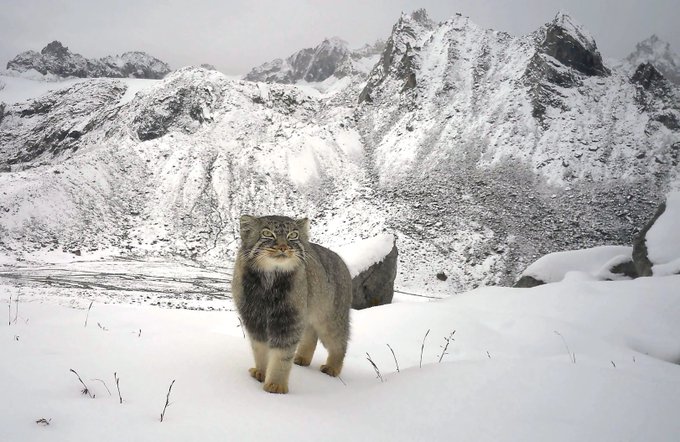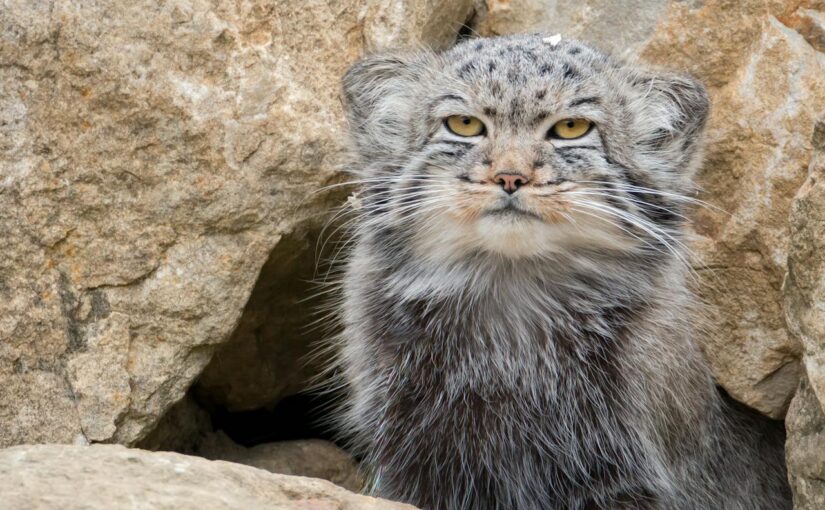The lofty valleys and snow-dusted ridges of Arunachal Pradesh soar with quiet majesty. In this remote northeastern frontier of India, swirling mists cloak ancient forests and alpine meadows, where few humans have tread. This wilderness, rugged and vibrant with life, recently yielded a stunning secret. The first-ever photographic evidence of the elusive Pallas’s cat was captured prowling its Himalayan reaches. Wildlife enthusiasts and conservationists alike are abuzz. This discovery does more than extend the known range of this rare feline; it shines a new spotlight on the ecological riches and mysteries of Arunachal’s highlands.
A Grumpy Charmer: Meet the Pallas’s Cat
Few wildcats stir curiosity like the Pallas’s cat (Otocolobus manul). Small but stout, standing less than two feet at the shoulder, this feline has a look all its own. Its face is impossibly round, ears set low and wide, and its mouth is set in a seemingly perpetual frown. The luxuriously fluffy gray-and-white coat puffs out in cold weather, making the cat appear much larger than it is. This serves as a clever illusion against stalking predators or prey. The dense fur is not just for show, shielding the cat from bitter winds and icy stones.
Pallas’s cats are supreme masters of misdirection and concealment. Their silver coats blend seamlessly into rocky slopes and scree fields. These cats prowl during the dim hours of dusk and dawn, relying on stealth to ambush prey such as voles, pikas, and ground birds. Watching a Pallas’s cat hunt, one can see its ancient evolutionary heritage. These cats diverged from the leopard lineage around five million years ago, making them one of the oldest surviving wild cats on the planet.
Historically, Pallas’s cats have inhabited the high-altitude grasslands and steppes stretching from Mongolia and Tibet to Central Asia. Spotting one in the alpine terrain of Arunachal Pradesh, thousands of kilometers from their better-known haunts, is both astonishing and deeply thrilling for scientists. Classified as Near Threatened on the IUCN Red List, the species faces threats from habitat loss, climate change, and human encroachment, with declining numbers in many areas.
Read more: The Pallas’s Cat: A Wild Gremlin of the Steppes
The Moment of Discovery
The breakthrough came during an ambitious field survey conducted between July and September 2024. Researchers from WWF-India and the Arunachal Pradesh Forest Department, in close collaboration with local Brokpa herding communities, deployed a vast network of 136 camera traps across 83 locations. This effort covered an area of 2,000 square kilometers in the West Kameng and Tawang districts. These alpine regions, perched at dizzying elevations above 4,000 meters (13,000 feet), present some of the harshest and least explored wildlife habitats anywhere in India.

Day after day, the field team tended to cameras through bone-freezing winds and treacherous paths (all the while sharing stories with local residents whose pastoral traditions are intertwined with the high mountain terrain). When the camera traps were finally collected and their memory cards pored over, an image emerged. The Pallas’s cat, caught in a candid moment, stood with dense fur bristling against the frozen hush and wide eyes mesmerizingly wild. The photograph, captured at nearly 5,000 meters elevation, marked not just a first for Arunachal Pradesh but also set a new elevation record for the species in the Eastern Himalayas.
“The discovery of Pallas’s cat in Arunachal Pradesh at nearly 5,000 meters is a powerful reminder of how little we still know about life in the high Himalayas,” said Dr. Rishi Kumar Sharma, Head, Science and Conservation, Himalayas Programme at WWF-India. “That this fragile landscape can support snow leopards, clouded leopards, and now Pallas’s cat alongside vibrant local traditions speaks to its extraordinary richness and resilience”.
Arunachal Pradesh: India’s Ecological Crown
Nestled in the Eastern Himalayas, Arunachal Pradesh is a vibrant tapestry of snow-fed rivers, bamboo forests, alpine meadows, and vast tracts of temperate and tropical rainforests. This region, long celebrated among biologists as a global biodiversity hotspot, is home to more than 5,000 flowering plant species, hundreds of bird types, and a dazzling variety of mammals, including some of the world’s most enigmatic carnivores. Here, red pandas teeter through mossy branches while herds of takin graze windswept slopes. The mighty snow leopard prowls icy crags, sharing the heights with the rare clouded and marbled leopards.
Arunachal’s status as a sanctuary for rare and endangered fauna cannot be overstated. The recent survey that captured the Pallas’s cat also revealed record-breaking high-altitude sightings of clouded leopards, marbled cats, and even the Himalayan wood owl. This riotous diversity highlights the region’s unique role as a crossroads for species from the Indian, Chinese, Indo-Malayan, and Palearctic realms.
At the heart of this richness lie the communities who have tended these rangelands for centuries. Their traditional knowledge is indispensable in mapping wildlife corridors and understanding animal behavior. “These findings reaffirm Arunachal Pradesh’s status as a global biodiversity hotspot,” noted Shri Ngilyang Tam, Principal Chief Conservator of Forests (Wildlife and Biodiversity) for the state. “They highlight the importance of continued investment in science-based, community-led conservation”.
Echoes for Conservation: Why This Discovery Matters
Finding the Pallas’s cat in Arunachal Pradesh changes more than just a map. It urges a rethinking of the region’s conservation priorities. For one, it proves that these forests and grasslands, often at risk from habitat fragmentation, climate change, and increasing human-wildlife conflict, still hold hidden treasures. The cat’s presence signals a robust, resilient habitat (one that can support not just native species but migrants or range expanders as well).
Yet, the challenges are daunting. Covering such a vast and mountainous area makes systematic monitoring difficult and expensive. Elusive species like the Pallas’s cat evade even the most advanced camera traps, meaning ongoing research will require creative approaches (potentially including environmental DNA sampling, more robust camera trapping, and the involvement of herders as “citizen scientists”).
Greater funding, stronger policy measures, and expanded protected areas are clearly warranted. Building partnerships with local communities, who have a wealth of practical knowledge and a vested interest in the outcome, must form the cornerstone of any conservation strategy. As Dr. Sharma emphasized in a press release, “Conserving elusive high-altitude species depends on strong local stewardship, scientific inquiry, and global support. This discovery is both a milestone and a motivation for what is still possible.”
Encouragingly, initiatives like WWF-India’s “Reviving Trans-Himalayan Rangelands: A Community-led Vision for People and Nature,” which underwrote the survey, promise a scalable blueprint for future action in Arunachal and beyond.
A New Chapter Begins: “Himalayan Shadows Unveiled”
In the wild, silent heights of India’s Northeast, a small cat with a serious face has stepped into the spotlight, inviting us to look up from the familiar and glimpse the untold. This photographic proof of the Pallas’s cat is not merely a trophy for wildlife researchers. It is a signpost pointing toward uncharted realms of biodiversity waiting to be understood, valued, and protected.
For the casual reader, this story is an invitation to marvel at how much still hides in the folds of our earth, and perhaps to plan a responsible journey to Arunachal’s mystical valleys. For wildlife enthusiasts and conservationists, it is a clarion call: support research, demand protection for fragile habitats, and cherish the traditions and wisdom of mountain communities.
The future of Arunachal Pradesh’s wildlife depends on this blend of discovery, stewardship, and shared wonder. Who knows what else may be glimpsed in the camera’s eye, just beyond the next ridge? With perseverance and curiosity, the mountain shadows may yet reveal many more secrets, each unlocking new hopes for the world’s wildest corners.
Photo by Radovan Zierik.
If you find joy in these tales of twitching whiskers and gleaming eyes, consider helping keep Whiskerito.com alive and purring. Your donation supports thoughtful research, engaging content, and the warm, wonder-filled community that makes this space what it is.
